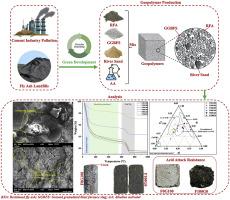粉煤灰转化为资产:评价再生粉煤灰在地聚合物生产中的效果
IF 10
1区 环境科学与生态学
Q1 ENGINEERING, ENVIRONMENTAL
引用次数: 0
摘要
由于燃煤电厂的关闭,用于生产建筑材料的常规粉煤灰(CFA)的可用性已经减少。同时,垃圾填埋粉煤灰和普通硅酸盐水泥(OPC)的生产对环境和健康构成了重大威胁。因此,为了满足对可持续和耐用建筑材料日益增长的需求,必须有CFA和OPC的替代品。本研究考察了含再生粉煤灰(RFA)作为可持续前驱体材料,替代水平分别为0、20、40、60、80和100%的磨粒高炉渣(GGBFS)基地聚合物的性能。这些地聚合物的性能通过物理、机械、耐久性和微观结构分析进行了全面评估。研究结果表明,与GGBFS相比,RFA由于其球形颗粒形状(类似于CFA)而增强了地聚合物的流动性。然而,与富含RFA的样品相比,ggbfs主导的样品在强度和一些耐久性性能方面表现出优越的性能,这可能是由于RFA的聚合速度较慢。此外,具有RFA的地聚合物表现出更好的耐碱-二氧化硅反应性、冻融循环和高温暴露。显微结构分析表明,RFA的反应性、非晶相和键合结构与CFA相似。虽然纯RFA可能不是生产地聚合物的理想选择,但将其与GGBFS混合可以满足性能标准,并有助于减少填埋粉煤灰的负担。值得注意的是,RFA约为60%的地聚合物在平衡性能和可持续性方面特别合适。这种混合物还解决了CFA的供需缺口,缓解了环境恶化,减少了对OPC的依赖。本文章由计算机程序翻译,如有差异,请以英文原文为准。


Ash to asset: Evaluating the efficacy of reclaimed fly ash in geopolymer production
The availability of conventional fly ash (CFA) for producing building materials has decreased due to the closure of coal-fired power plants. Meanwhile, landfilled fly ash and the production of ordinary portland cement (OPC) present significant environmental and health threats. Thus, substitutes for CFA and OPC are necessary to meet the growing demand for sustainable and durable building materials. This study investigates the performance of ground granulated blast furnace slag (GGBFS)-based geopolymers that incorporate reclaimed fly ash (RFA) as a sustainable precursor material at replacement levels of 0, 20, 40, 60, 80, and 100 %. The performance of these geopolymers was thoroughly evaluated through physical, mechanical, durability, and microstructural analyses. The findings showed that RFA enhances the fluidity of geopolymers compared to GGBFS due to its spherical particle shape, similar to CFA. However, GGBFS-dominated specimens exhibited superior performance in strength and some durability properties compared to RFA-rich counterparts, likely due to the slower polymerization of RFA. Additionally, geopolymers with RFA demonstrated better resistance to alkali-silica reactivity, freeze-thaw cycles, and high-temperature exposure. Microstructural analysis revealed that the reactivity, amorphous phases, and bonding structure of RFA are like those of CFA. Although pure RFA may not be ideal for producing geopolymers, blending it with GGBFS meets performance standards and helps reduce the burden of landfilled fly ash. Notably, geopolymers with ≤60 % RFA were found to be particularly suitable, balancing performance and sustainability. Using RFA helps addresses the supply-demand gap of CFA, mitigating environmental degradation and reducing reliance on OPC.
求助全文
通过发布文献求助,成功后即可免费获取论文全文。
去求助
来源期刊

Journal of Cleaner Production
环境科学-工程:环境
CiteScore
20.40
自引率
9.00%
发文量
4720
审稿时长
111 days
期刊介绍:
The Journal of Cleaner Production is an international, transdisciplinary journal that addresses and discusses theoretical and practical Cleaner Production, Environmental, and Sustainability issues. It aims to help societies become more sustainable by focusing on the concept of 'Cleaner Production', which aims at preventing waste production and increasing efficiencies in energy, water, resources, and human capital use. The journal serves as a platform for corporations, governments, education institutions, regions, and societies to engage in discussions and research related to Cleaner Production, environmental, and sustainability practices.
 求助内容:
求助内容: 应助结果提醒方式:
应助结果提醒方式:


